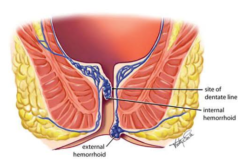
Hemorrhoids, swollen veins located in the lower rectum or around the anus, are common but can sometimes lead to discomfort or pain. They are typically categorized into two types: internal hemorrhoids, which occur within the rectum, and external hemorrhoids, which occur under the skin around the anus. Understanding the symptoms of hemorrhoids is crucial for determining the appropriate treatment, including when surgery might be necessary.
Symptoms of Hemorrhoids
Symptoms vary depending on whether the hemorrhoids are internal or external, but they can include:
- Bleeding: This is often the first sign of internal hemorrhoids. You might notice bright red blood on the toilet paper or in the toilet bowl after a bowel movement.
- Pain and Discomfort: External hemorrhoids can cause pain, especially if they become thrombosed (develop a clot inside). The pain can be significant and is often accompanied by swelling.
- Itching or Irritation: The area around your anus may feel itchy or irritated, particularly with external hemorrhoids.
- Lumps: An external hemorrhoid can feel like a hard, sensitive lump near your anus. This can also occur with thrombosed hemorrhoids.
- Leakage: Hemorrhoids can cause fecal leakage, contributing to skin irritation around the anus.
When Is Surgery Needed?
Many hemorrhoid symptoms can be effectively managed with lifestyle changes, dietary adjustments, and over-the-counter treatments. However, surgery might be considered in the following scenarios:
- Severe Discomfort or Pain: If hemorrhoids cause significant pain or discomfort that is not relieved by standard treatments.
- Persistent Bleeding: Ongoing bleeding from hemorrhoids that leads to anemia or is significantly impacting quality of life may necessitate surgical intervention.
- Thrombosed Hemorrhoids: Thrombosed external hemorrhoids can be extremely painful and might require surgery if they do not improve with conservative treatments.
- Prolapsed Hemorrhoids: Internal hemorrhoids that protrude from the anus (prolapsed hemorrhoids) and cannot be pushed back in may require surgical removal.
Surgical Treatment Options
Several surgical techniques are available for treating hemorrhoids, depending on their severity and the patient's overall health:
- Hemorrhoidectomy: This procedure involves the complete removal of the hemorrhoid tissue. It's considered the most effective method for severe or recurrent hemorrhoids but involves a longer recovery period.
- Rubber Band Ligation: This minimally invasive procedure is commonly used for internal hemorrhoids. A rubber band is placed around the base of the hemorrhoid, cutting off its blood supply and causing it to wither and fall off.
- Sclerotherapy: A chemical solution is injected into the hemorrhoid tissue to shrink it. This method is often used for smaller hemorrhoids.
- Infrared Coagulation: Infrared light is used to cause scar tissue, which cuts off the blood supply to the hemorrhoid, causing it to shrink. This technique is suitable for small to medium-sized hemorrhoids.
Recovery and Post-Surgical Care
Recovery from hemorrhoid surgery varies based on the type of procedure performed and the individual's health. Generally, patients can expect a recovery period ranging from a few days to a few weeks. It's important to follow post-surgical care instructions closely, which may include pain management strategies, dietary changes to ensure soft bowel movements, and maintaining good hygiene around the surgical area. Activities that strain the rectal area, such as heavy lifting or prolonged sitting, should be avoided during the recovery phase. Patients are also advised to schedule follow-up visits with their doctor to monitor healing and prevent complications.
Preventing Hemorrhoids
Preventing hemorrhoids largely revolves around leading a lifestyle that promotes healthy bowel movements and reduces strain on the blood vessels in the rectal area. This can be achieved through regular exercise, staying adequately hydrated, and consuming a high-fiber diet to prevent constipation and ensure easier, strain-free bowel movements. Additionally, avoiding extended periods of sitting, especially on the toilet, can help reduce the risk of developing hemorrhoids. Good hygiene practices and using the bathroom as soon as the urge arises are also crucial in preventing unnecessary strain and maintaining rectal health.
Conclusion
While hemorrhoids can be a source of discomfort, understanding the symptoms and available treatments, including surgical options, can help manage this condition effectively. If you experience persistent or severe symptoms of hemorrhoids, consulting with a healthcare professional is important to determine the most appropriate treatment strategy and to rule out more serious conditions that can mimic hemorrhoid symptoms. With the right approach, most people can achieve significant relief from hemorrhoid symptoms and improve their quality of life.
